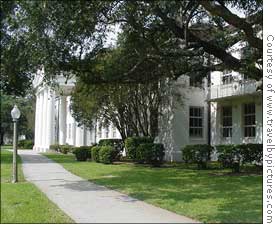
| << Front page | News | September 16, 2005 |
Oberlin aids damaged college
Rebuilding Dillard
 |
||
| Dillard University: The campus as it looked before the devastation of Katrina. | ||
Oberlin’s administration has responded to Hurricane Katrina with a pledge to assist decimated Dillard University of New Orleans. This follows a series of actions by the Oberlin community including admitting three students from Tulane Univeristy and holding several student and faculty organized panels.
Dillard University is a historically African-American institution and one of the top ranked liberal arts schools in the nation. Its campus is on the National Register of Historic Places. But when Katrina hit, large holes were punched in the roofs of two of the campus buildings, and there was a breach in the nearby 17th Street Canal levee that flooded the campus with five to eight feet of water. Although all Dillard students were evacuated safely, the University still faces a formidable challenge in rebuilding and repairing its 55-acre campus. This is where Oberlin intends to help.
In the week after Katrina hit, President Nancy Dye spoke with Dr. Michael Lomax of the United Negro College Fund, an organization that is coordinating efforts to help rebuild the black colleges and universities affected by the hurricane.
“He made very clear to us that the best way to help is to donate money to the rebuilding effort,” wrote Dye in an e-mail to students and faculty.
Already, Dye has stated the College’s senior administration has pledged “at least $10,000.” The Oberlin Development Fund is coordinating further efforts. At about 7 p.m. on Monday, Sept. 12, the Development Fund office sent an e-mail to alumni asking for donations to help with the fundraising endeavor. As of Thursday morning, alumni had responded to the e-mail with $24,708 from 251 donors.
“The overall response has been positive,” said Aaron Mucciolo, assistant director of the Oberlin Fund office in Development.
“Money for this effort will come from individual donations, including funds raised by concerts, cash collections and other programs,” elaborated Diana Roose, assistant to Dye. There is a box for cash donations in Wilder Hall and the College hosts a website where donations can be made by credit card at www.oberlin.edu/dillard. The contributions from alumni, students, staff and faculty continue to come in.
Although there is no historical or official link between Oberlin and Dillard, the administration feels that assisting Dillard in this time of crisis is very much in keeping with Oberlin’s tradition as a progressive educational institution. Oberlin alumni were instrumental in establishing many historically black colleges and universities. And Oberlin was the first institution of higher learning to admit all students, regardless of race.
“This fund is very much in the tradition of Oberlin’s 19th century commitment to abolitionism and access to education for all,” said Roose.
The student body also seems to support the administrations’ efforts.
“I think it’s great to see Oberlin living up to its ‘save the world’ ethos,” said College first-year Sam Harmet.
Dillard University hopes that with the support of Oberlin and others it will be able to reopen by January 2006.
“This journey to recovery will be long and arduous,” ends a
letter sent by Dillard University on Sept. 2. “We are guided by our
unwavering belief and absolute confidence that Dillard University will be back
and better.”
About us
Subscriptions
Advertising